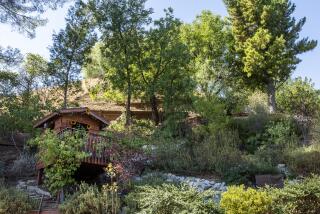Many Ways to Make Gardens Less Thirsty
- Share via
Some of the new ways of using water in the garden are more proven than others.
New ideas on how to prepare the soil before planting and new soil additives promise water savings but aren’t completely proved, although some of the new additives, polymers dubbed “super sponges,” look very promising. Caltrans, for one, is giving them a try, but as one engineer put it, “the results are impressive but not conclusive.”
Mulches are an old standby for saving water and they are looking better every day as more and more individuals and organizations, such as the Los Angeles State and County Arboretum, give them a serious try.
At the arboretum, mulching has not only saved considerable water, but mulches combined with deep, infrequent irrigation have kept their tall trees from toppling in strong Santa Ana winds, a serious problem before.
But good mulches are hard to find, so more and more people are making their own using the new breed of compost grinders that makes mincemeat of garden refuse. Reusing these materials in the garden to cut down on the evaporation of water from the soil also will keep them out of landfills and help ease the trash crunch.
Here too, legislation might provide additional reasons to mulch because new “green waste” laws are going to require up to a 50% reduction in the amount of garden trimmings going to dumps in the mid-1990s.
New irrigation technology is perhaps the most interesting new way with water, and the most confusing for those easily baffled by numbers or mechanical devices. But drip systems are no longer experimental--they have become reliable in the last few years. They promise to replace ordinary sprinklers for the irrigation of everything but lawns. Sprinklers are still the only way to water lawns; other devices have been notable failures.
Advances such as “turbulent path” emitters ingeniously help keep systems from clogging, as do the new, more efficient filters. And many new systems are pressure-compensated so the same amount of water comes out at the far end of the system as at the end near the spigot, which makes hillside installations much easier.
How much can you save simply by changing how you water?
From “30% to 70%” is the answer given by Joseph Hung, chairman of the Agricultural Engineering Department at Cal Poly Pomona and an authority on drip irrigation.
Janet Hartin, with the UC Cooperative Extension in San Bernardino, goes so far as to say, “The efficiency of an irrigation system is more important than what you plant.”
And there are the new mini-sprinklers or micro-sprinklers that apply water almost as slowly as a true drip system, so it can all soak in and very little is lost to the atmosphere.
They are also extremely easy to install or modify once installed and a whole lot easier to figure out, although they are not as thrifty as true drip systems. They are ideally suited for areas of ground cover.
Then there is “gray water” and its reuse in the landscape, which some consider the solution to sewage problems as well as water problems. Only Santa Barbara County has made it legal to use; the rest of us are technically breaking the law if we reuse water from the two preferred sources--the washing machine or shower.
There are health considerations, but there are also proponents who can counter every claim, and they have developed some simple but effective rules for the use of gray water in the garden.
One basic rule is that “you cannot store gray water--it must be applied to the ground immediately,” says Robert Kourik, who wrote the book on this subject (“Gray Water Use in the Landscape”).
“There is one good thing about the drought,” said Santa Barbara landscape architect Joan F. Radditz, who confesses to getting tired of short showers and dying gardens. “Nurseries are introducing all sorts of new and interesting plants.”
This is yet another new way--using plants that use less water in the first place, most of which also happen to look more at home in the California garden.
We are not talking cactus here. They and other succulents certainly have a place in the California garden, but this is not the desert despite what some people say. The desert is quite a few miles to the east.
Most of the inhabited sections of Santa Barbara, Ventura, Los Angeles, Orange, San Bernardino, Riverside and San Diego counties are not desert but Mediterranean climates, which--before man came along--were composed of oak and grass savannas or bushy chaparral, with the occasional lush stream bottom.
Near the coast, the land was so wet it was naturally boggy and choked with willows and other water-loving plants that hindered early explorers.
The new plants are from other Mediterranean climates, such as Australia, Chile, South Africa and the Mediterranean itself. They are leafy, flowering plants, as pretty as can be, but not always as bright a green as some might wish. In exchange, there are other foliage colors, including elegant olive-greens and grays, and often spectacular flowers.
Native California plants, long prized in other countries, are finally getting some recognition at home. And they have benefits beyond water-saving--sweet scents for one.
Drought-resistant plants are not a cure-all, however.
Mediterranean plants tend to be short-lived and they are not as care-free as some say. Most quickly become established in a garden, but sudden death may be their fate after a few years. Many Mediterranean and most native plants do best on natural hillsides, where drainage is naturally good. They are less happy on cuts and building pads and are least happy on valley bottoms.
Some are naturally more forgiving and tougher than others. Two popular ground covers from South Africa illustrate this point: Cape weed ( Arctotheca ) makes a long-lasting, dense ground cover that is nearly bulletproof; gazanias are prettier but short-lived, and plantings tend to develop holes after a few years where plants have died out.
Many of the drought-resistant plants that do so well on the hillsides are also as flammable as the native vegetation, so hillside gardens tend to be irrigated and little different from gardens down below.
Some of the new ways deal with this chaparral/urban interface.
Those of us on the flatlands should approach these new plants with eyes open. Most of the level areas of Southern California were not rich is plant life, but were simple grasslands, green in winter but dry in summer.
Most of the showy and spectacular plant life--the California lilacs, matillija poppies, penstemons and even prickly pear--preferred the hills.
In a sense, most of the now-populated parts of Southern California were one big lawn, composed of perennial grasses that survived the summer by simply going dormant.
Flatlanders will probably have better luck with partially irrigated gardens that use plants that can tolerate a heavy soil and some summer water, which most natives, and many Mediterranean plants, do not.
Take these two drought-tough plants as an example: Pittosporums thrive in the clay valley bottom soils, but the lovely rock roses do not.
Both plants are drought-resistant, but one is downright intolerant of water or a heavy soil. Learning which is which is one of the most satisfying and adventuresome new ways with water, as you learn to work with living things.
And in learning to live with the drought, don’t think it’s “out with the old and in with the new.”
According to Peggy McLaughlin at Cal Poly Pomona, “many of the plants already in gardens are quite drought-tolerant,” we simply need to water them less. There are a lot of familiar names on any list of drought-resistant plants--acacias, cotoneaster, carrot wood, dodonea, junipers, pyracantha.
“You don’t have to start from scratch,” she said. “Keep in mind that old, established plantings are most likely drought-resistant. They can adapt to a new irrigation and management scheme.”
Also keep in mind that now--the middle of summer--is not the time to do anything radical in a garden. Wait for cooler weather in the fall.
Those intent on preserving their lawn, or a portion of it, will discover that there are new lawn grasses that use less water.
One is a hybrid zoysia grass named “El Toro,” developed by the University of California. It needs about half as much water as the most commonly planted drought-resistant grass, the faddish tall fescues, which now account for about 80% of sod sales.
Lawns, however dead in Santa Barbara and dying elsewhere as people try to cut back on water use the easy way, are one casualty of the drought that may never completely recover. Expect lawns to be a smaller, though perhaps a more precious part of any landscape in the very near future.
Expect to water lawns more precisely as well, because new information is available, and new gear that does a better job, including computer-guided controllers.
Here’s where you want to learn about “the ET rate,” or evapotranspiration rate, because it can tell you how much water a plant needs, based on what it loses to the atmosphere during a given week.
The very design of gardens is one of the new ways.
The traditional garden plan and look--lots of lawn surrounded by a few shrubs and flowers--developed in climates far wetter than our own, is beginning to give way to a definite “California look” that resembles the south of France more than it does the gardens of our own East Coast.
In these new designs, look for more paving of the permeable sort, that allows water to soak through to plant roots below. Look for more shade trees that cool that paving (and the house). Look for more shrubs and ground covers and areas (under trees for instance) that are simply mulched.
Don’t look for big swathes of gravel or ground bark because they so increase the temperature in the garden and around the house that they require greatly increased cooling costs.
Put all of these ideas together and you have a xeriscape-- a landscape that is water efficient. This word, only coined in 1980 by the Denver Water Department, is much abused.






